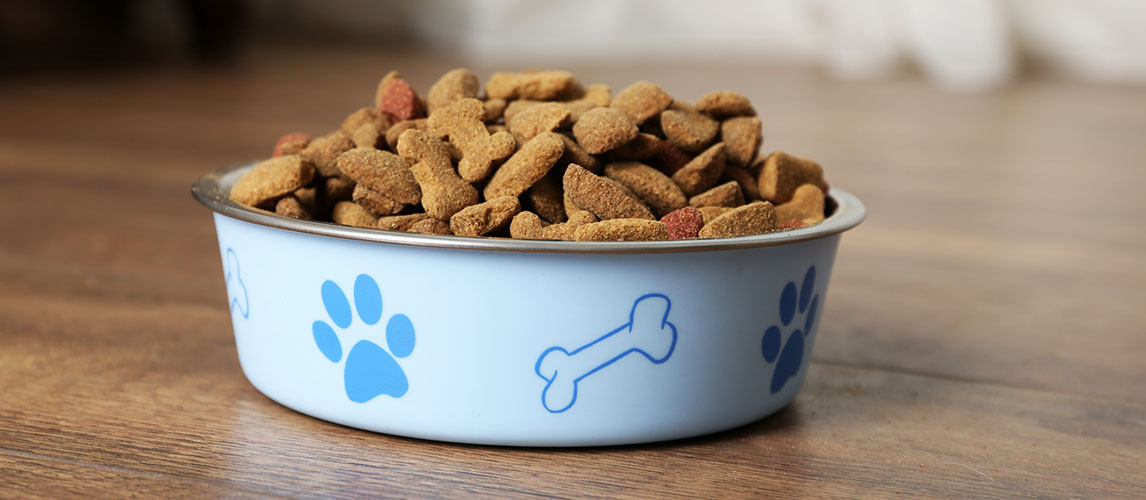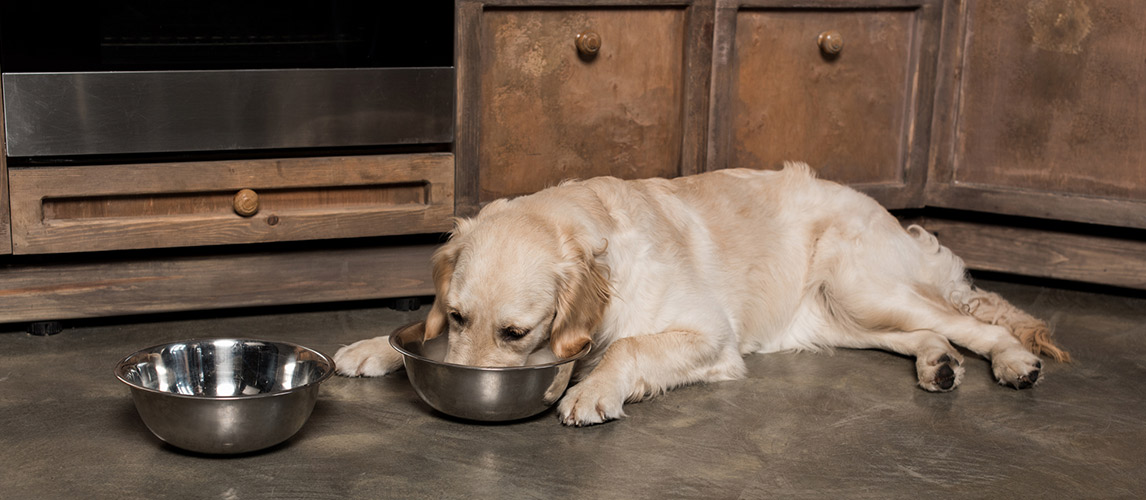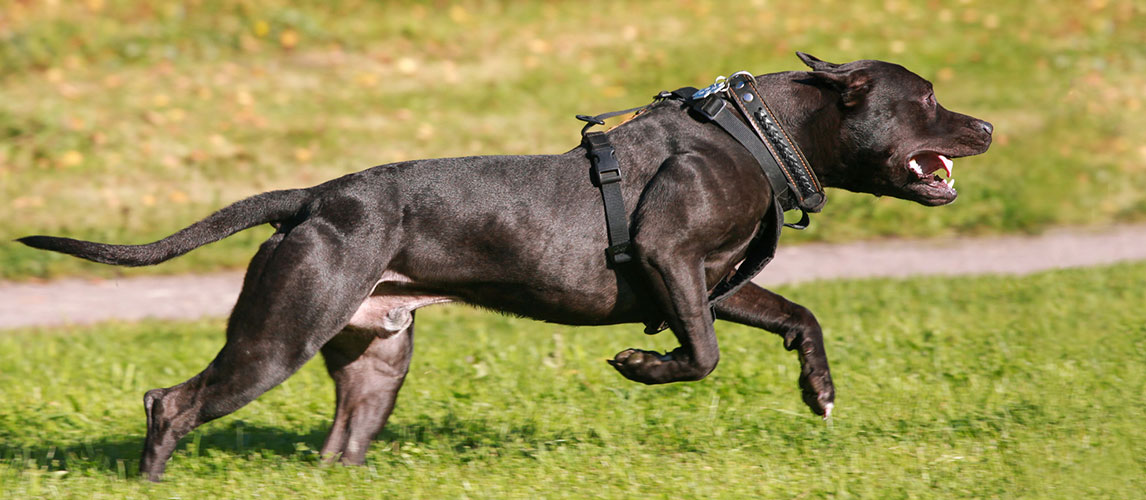Man’s best friend can also gain weight, leading to obesity if not managed appropriately, and potentially increasing the risk for metabolic abnormalities like diabetes and cardiovascular disorders. There is also a fatty liver disease that you may need to worry about. Protect your pet from the complications of obesity by giving it any of these best dog foods for weight loss. You’ll be glad your pet is able to reduce its weight as this will translate to improved quality of life for your dog.
The 7 Top-Rated Dog Foods for Weight Loss
1 Wellness CORE Grain-Free Reduced Fat Turkey

- Brand: Wellness CORE
- First 5 ingredients: Deboned Turkey, Turkey Meal (source of Glucosamine), Chicken Meal (source of Chondroitin Sulfate), Lentils, Peas
- Primary Protein Source: Turkey & Chicken
- Calories: 366 kcal/cup
- Flavor: Turkey & Chicken
- Life Stage: Adult
The Wellness Core Natural Grain Free Reduced Fat Formula Dry Dog Food is an excellent choice when you have a dog that has weight issues. It has below-average calories and fats yet beefs it up in terms of its protein content. The addition of glucosamine in its formulation also helps support joint function as the joints are basically the weight-bearing points of the dog’s body. Strengthening the joints should help your dog carry its weight while you’re reducing it with this Wellness product.
Deboned Turkey, Turkey Meal (source of Glucosamine), Chicken Meal (source of Chondroitin Sulfate), Lentils, Peas, Dried Ground Potatoes, Pea Fiber, Ground Flaxseed, Tomato Pomace, Chicken Fat (preserved with Mixed Tocopherols), Natural Chicken Flavor, Salmon Oil, Taurine, Vitamin E Supplement, Choline Chloride, Spinach, Broccoli, Carrots, Parsley, Apples, Blueberries, Kale, Zinc Proteinate, Mixed Tocopherols added to preserve freshness, Zinc Sulfate, Calcium Carbonate, Niacin, Iron Proteinate, Ferrous Sulfate, Vitamin A Supplement, Copper Sulfate, Thiamine Mononitrate, Copper Proteinate, Manganese Proteinate, Manganese Sulfate, d-Calcium Pantothenate, Sodium Selenite, Pyridoxine Hydrochloride, Riboflavin, Biotin, Vitamin D3 Supplement, Chicory Root Extract, Yucca Schidigera Extract, Calcium Iodate, Vitamin B12 Supplement, Folic Acid, Ascorbic Acid (Vitamin C), Dried Lactobacillus plantarum Fermentation Product, Dried Enterococcus faecium Fermentation Product, Dried Lactobacillus casei Fermentation Product, Dried Lactobacillus acidophilus Fermentation Product, Rosemary Extract, Green Tea Extract, Spearmint Extract.

2 Blue Buffalo Freedom Adult Healthy Weight Chicken
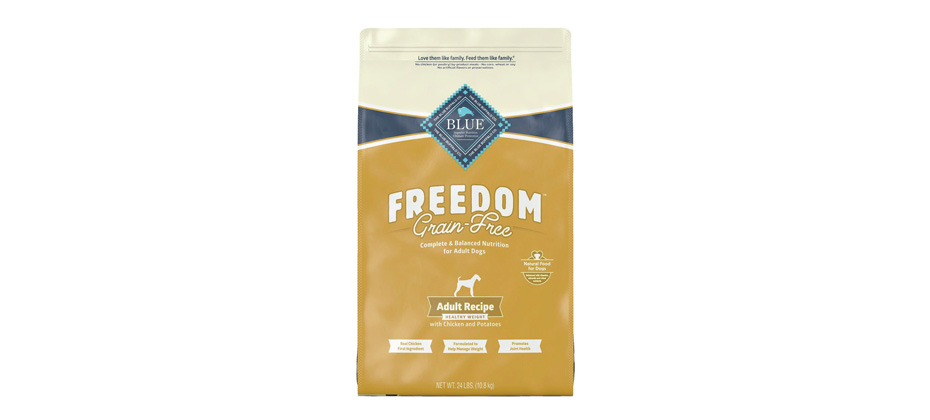
- Brand: Blue Buffalo
- First 5 ingredients: Deboned Chicken, Chicken Meal, Peas, Potatoes, Pea Starch
- Primary Protein Source: Chicken
- Calories: 330 kcal/cup
- Flavor: Chicken
- Life Stage: Adult
Blue Buffalo’s Freedom Grain Free Healthy Weight Chicken Recipe comes in as a low-calorie, low-fat, and average-protein dog food that should help dogs lose weight. Also added into its formulation is l-carnitine, a substance well-known for its fat-burning properties. When combined with glucosamine, this can help provide for a more effective canine weight loss diet since the addition of glucosamine enhances the weight-bearing capabilities of the joints. This allows your dog to increase its physical activities so that you’ll get better weight loss results.
Is your pup sensitive to certain ingredients? Then feed him Blue Buffalo’s Freedom Adult Healthy Weight Chicken Recipe Grain-Free Dry Dog Food! This delicious, 100% grain-free and gluten-free kibble features real deboned chicken first and is completely free from any poultry by-product meals, corn, wheat, soy and artificial flavors and preservatives. And since it’s specifically designed to help your pup achieve and maintain a healthy weight, it contains a balance of calories and fat! It also includes BLUE’s exclusive LifeSource Bits—a combination of selected antioxidants, minerals and vitamins picked by veterinarians and animal nutritionists to support your pup’s overall health and wellness. Now your paw-tner really has something to wag his tail about!
Deboned Chicken, Chicken Meal, Peas, Potatoes, Pea Starch, Tapioca Starch, Pea Fiber, Potato Starch, Natural Flavor, Dried Tomato Pomace, Flaxseed (source of Omega 3 and 6 Fatty Acids), Chicken Fat (preserved with Mixed Tocopherols), Pea Protein, Powdered Cellulose, Dicalcium Phosphate, Dehydrated Alfalfa Meal, Potassium Chloride, Choline Chloride, Dried Chicory Root, Alfalfa Nutrient Concentrate, Calcium Carbonate, DL-Methionine, Salt, preserved with Mixed Tocopherols, Sweet Potatoes, Carrots, L-Carnitine, Garlic, Zinc Amino Acid Chelate, Zinc Sulfate, Vegetable juice for color, Ferrous Sulfate, Vitamin E Supplement, Glucosamine Hydrochloride, Iron Amino Acid Chelate, Blueberries, Cranberries, Barley Grass, Parsley, Turmeric, Dried Kelp, Yucca Schidigera Extract, Niacin (Vitamin B3), Calcium Pantothenate (Vitamin B5), L-Ascorbyl-2-Polyphosphate (source of Vitamin C), L-Lysine, Copper Sulfate, Biotin (Vitamin B7), Vitamin A Supplement, Copper Amino Acid Chelate, Manganese Sulfate, Taurine, Chondroitin Sulfate, Manganese Amino Acid Chelate, Thiamine Mononitrate (Vitamin B1), Riboflavin (Vitamin B2), Vitamin D3 Supplement, Vitamin B12 Supplement, Pyridoxine Hydrochloride (Vitamin B6), Calcium Iodate, Dried Yeast, Dried Enterococcus faecium fermentation product, Dried Lactobacillus acidophilus fermentation product, Dried Aspergillus niger fermentation extract, Dried Trichoderma longibrachiatum fermentation extract, Dried Bacillus subtilis fermentation extract, Folic Acid (Vitamin B9), Sodium Selenite, Oil of Rosemary.

3 Wellness Complete Health Healthy Weight Dog Food

- Brand: Wellness Complete
- First 5 ingredients: Deboned Chicken, Chicken Meal, Oatmeal, Ground Brown Rice, Ground Barley
- Primary Protein Source: Deboned Chicken
- Calories: 405 kcal/cup
- Flavor: Deboned Chicken & Peas
- Life Stage: Adult
Compared to the other products in this list, the Wellness Complete Health Healthy Weight Natural Dry Dog Food is not actually low-calorie dog food. Instead, it can be aptly classified as average. The good news is that Wellness has added chondroitin and glucosamine in the formulation to strengthen the joints and improve their ability to bear the weight of your dog’s body. It comes with probiotics, too, to help improve digestion, ensuring that all of the nutrients in the dog food are utilized by your pet to the fullest.
Deboned Chicken, Chicken Meal, Oatmeal, Ground Brown Rice, Ground Barley, Peas, Tomato Pomace, Rice, Ground Flaxseed, Tomatoes, Chicken Fat, Carrots, Natural Chicken Flavor, Potassium Chloride, Choline Chloride, Spinach, Vitamin E Supplement, Taurine, Zinc Proteinate, Mixed Tocopherols added to preserve freshness, Sweet Potatoes, Apples, Blueberries, Zinc Sulfate, Calcium Carbonate, Niacin, Ferrous Sulfate, Iron Proteinate, Vitamin A Supplement, Glucosamine Hydrochloride, Chondroitin Sulfate, Ascorbic Acid (Vitamin C), Copper Sulfate, Thiamine Mononitrate, Copper Proteinate, Chicory Root Extract, Manganese Proteinate, Manganese Sulfate, d-Calcium Pantothenate, Sodium Selenite, Pyridoxine Hydrochloride, Riboflavin, Yucca Schidigera Extract, Garlic Powder, Vitamin D3 Supplement, Biotin, Calcium Iodate, Vitamin B12 Supplement, Folic Acid, Dried Lactobacillus plantarum Fermentation Product, Dried Enterococcus faecium Fermentation Product, Dried Lactobacillus casei Fermentation Product, Dried Lactobacillus acidophilus Fermentation Product Rosemary Extract, Green Tea Extract, Spearmint Extract.

4 Instinct Raw Boost Healthy Weight Grain-Free

- Brand: Instinct
- First 5 ingredients: Chicken, Chicken Meal, Peas, Tapioca, Menhaden Fish Meal
- Primary Protein Source: Chicken
- Calories: 368 kcal/cup
- Flavor: Chicken
- Life Stage: Adult
Combining high-quality freeze-dried raw dog food with high-protein dog kibbles, Nature’s Variety Instinct Raw Boost Healthy Weight Natural Dry Dog Food makes its way into our list of canine weight loss diets because of its unique below-average calorie and fat content yet with exceptional protein content. L-carnitine is also added into the blend to provide for a more efficient fat-burning mechanism with each bite that your dog takes from its food bowl.
Chicken, Chicken Meal, Peas, Tapioca, Menhaden Fish Meal, Dried Tomato Pomace, Suncured Alfalfa Meal, Chicken Fat (preserved with Mixed Tocopherols and Citric Acid), Turkey Meal, Freeze Dried Chicken, Montmorillonite Clay, Natural Flavor, Freeze Dried Chicken Liver, Pumpkinseeds, Salt, Freeze Dried Chicken Heart, Vitamins (Vitamin E Supplement, Niacin Supplement, L-Ascorbyl-2-Polyphosphate, Thiamine Mononitrate, d-Calcium Pantothenate, Vitamin A Supplement, Riboflavin Supplement, Pyridoxine Hydrochloride, Vitamin B12 Supplement, Folic Acid, Vitamin D3 Supplement, Biotin), Carrots, Apples, Cranberries, Minerals (Zinc Proteinate, Iron Proteinate, Copper Proteinate, Manganese Proteinate, Sodium Selenite, Ethylenediamine Dihydriodide), Pumpkin, Choline Chloride, L-Carnitine, Potassium Chloride, Dried Kelp, Salmon Oil, Blueberries, Dried Bacillus coagulans Fermentation Product, Rosemary Extract.

5 Halo Holistic Healthy Weight Grain-Free Turkey
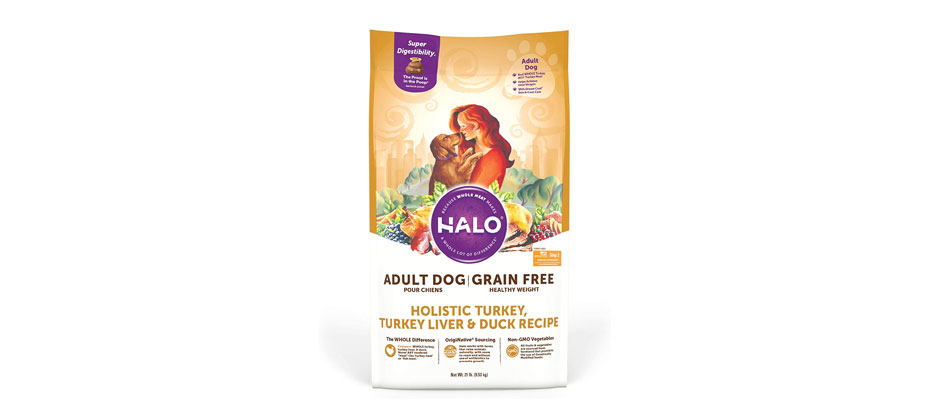
- Brand: Halo
- First 5 ingredients: Turkey, Dried Peas, Dried Chickpeas, Dried Egg Product, Dried Lentils
- Primary Protein Source: Turkey
- Calories: 380 kcal/cup
- Flavor: Dried Peas, Dried Chickpeas, Dried Egg Product, Dried Lentils
- Life Stage: Adult
Spot’s Stew Healthy Weight formulation comes in with the second-highest calorie content in this list, although it can still be considered as below-average. Its protein and fat contents are also below-average, making this Halo product a good choice for those that would like to have more bioavailable nutrients because of the exceptional digestibility of its ingredients. It has l-carnitine, too which can help improve metabolism leading to more efficient burning of fat.
Turkey, Dried Peas, Dried Chickpeas, Dried Egg Product, Dried Lentils, Dried Sweet Potatoes, Turkey Liver, Duck, Pea Fiber, Dicalcium Phosphate, Flaxseed, Natural Flavor, Pea Protein, Soy Protein Concentrate, Chicken Fat (Preserved With Mixed Tocopherols), Salmon Oil (Preserved With Mixed Tocopherols), Calcium Sulfate, Dried Bacillus Coagulans Fermentation Product, Salt, Dried Blueberries, Dried Cranberries, Dried Carrots, Calcium Carbonate, Inulin, Vitamins (Vitamin E Supplement, Niacin Supplement, Thiamine Mononitrate, D-Calcium Pantothenate, Vitamin A Supplement, Pyridoxine Hydrochloride, Riboflavin Supplement, Vitamin D3 Supplement, Vitamin B12 Supplement, Folic Acid, Biotin), Potassium Chloride, Minerals (Zinc Proteinate, Iron Proteinate, Copper Proteinate, Manganese Proteinate, Sodium Selenite, Calcium Iodate), Mixed Tocopherols (Preservative), Taurine, L-Carnitine.

6 Purina Pro Plan Focus Adult Weight Management
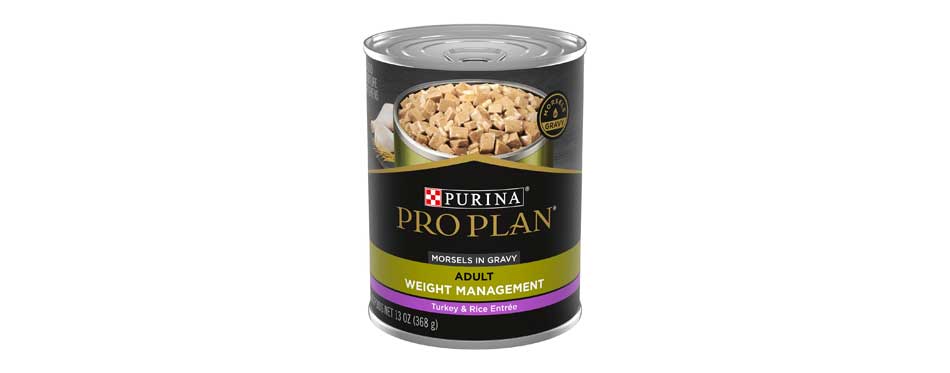
- Brand: Purina Pro Plan
- First 5 ingredients: Water, turkey, Liver, Wheat Gluten, Chicken
- Primary Protein Source: Turkey
- Calories: 306 kcal/can
- Flavor: Turkey & Rice
- Life Stage: Adult
Whether it is served as a standalone weight loss diet for your dog or as a topping for your pet’s weight loss dry kibbles, the Purina Pro Plan Focus Weight Management Canned Dog Food is always a good choice. It contains 25% less fat than the other entrees of Purina, helping your dog to lose weight without sacrificing on the other equally-important nutrients necessary for optimum health. Since the Pro Plan Focus has more protein and less fat you can sure your dog will be shedding those pounds away while maintaining lean muscle mass.
For more information on the brand, check out our review of Purina Pro Plan Dog Food.
New: Water, turkey, Liver, Wheat Gluten, Chicken, Corn Starch-Modified, Rice, Meat By-Products, MINERALS [Potassium Chloride, Zinc Sulfate, Ferrous Sulfate, Copper Sulfate, Manganese Sulfate, Potassium Iodide, Sodium Selenite], Tricalcium Phosphate, Salt, Choline Chloride, VITAMINS [Vitamin E Supplement, Niacin (Vitamin B-3), Thiamine Mononitrate (Vitamin B-1), Calcium Pantothenate (Vitamin B-5), Pyridoxine Hydrochloride (Vitamin B-6), Vitamin B-12 Supplement, Riboflavin Supplement (Vitamin B-2), Vitamin A Supplement, Folic Acid (Vitamin B-9), Vitamin D-3 Supplement, Biotin (Vitamin B-7)]. F444220.
Original: Water Sufficient for Processing, Turkey, Liver, Wheat Gluten, Rice, Chicken, Corn Starch Modified, Meat By Products, Potassium Chloride, Calcium Phosphate, Added Color, Salt, Calcium Carbonate, Choline Chloride, Zinc Sulfate, Vitamin E Supplement, Ferrous Sulfate, Niacin, Thiamine Mononitrate, Copper Sulfate, Calcium Pantothenate, Manganese Sulfate, Pyridoxine Hydrochloride, Vitamin B 12 Supplement, Riboflavin Supplement, Vitamin A Supplement, Folic Acid, Potassium Iodide, Vitamin D 3 Supplement, Biotin, and Sodium Selenite.
7 Eagle Pack Reduced Fat Adult Dry Dog Food
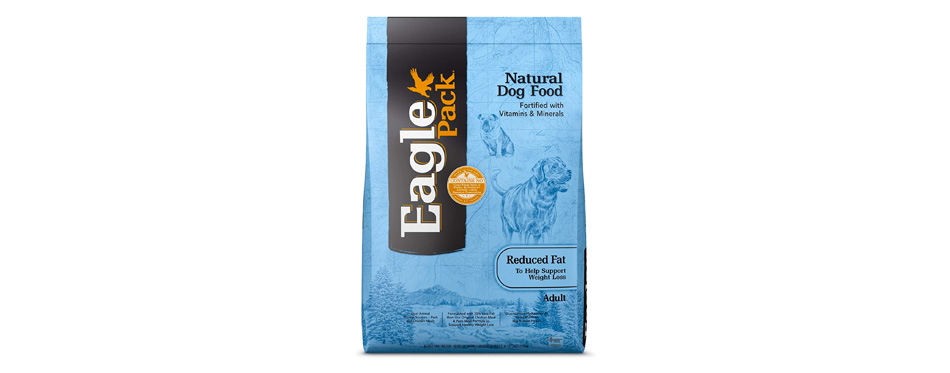
- Brand: Eagle Pack
- First 5 ingredients: Pork Meal, Dehulled Barley, Peas, Ground Brown Rice, Oatmeal
- Primary Protein Source: Pork Meal
- Calories: 343 kcal/cup
- Flavor: Dehulled Barley, Peas, Ground Brown Rice, Oatmeal
- Life Stage: Adult
Eagle Pack’s Reduced Fat Natural Dog Food boasts of the lowest fat content among the dry dog foods in this list at 6% minimum. It comes with glucosamine, too to aid in strengthening your dog’s joints so that it will be able to move freely even with its weight bearing down on its joints. There are botanicals and probiotics as well for improved digestion, ensuring that every single nutrient gets digested and absorbed for cellular utilization by your pet. The below-average calorie content can also help your dog in losing weight.
Pork Meal, Dehulled Barley, Peas, Ground Brown Rice, Oatmeal, Rice, Tomato Pomace, Chicken Meal, Turkey Meal, Flaxseed, Chicken Fat (preserved with Mixed Tocopherols), Brewers Dried Yeast, Potassium Chloride, Inulin, Vitamins [Vitamin E Supplement, Niacin, Vitamin A Supplement, Ascorbic Acid (Vitamin C), Thiamine Mononitrate, d-Calcium Pantothenate, Pyridoxine Hydrochloride, Riboflavin, Vitamin D3 Supplement, Biotin, Vitamin B12 Supplement, Folic Acid], Minerals [Zinc Proteinate, Zinc Sulfate, Iron Proteinate, Ferrous Sulfate, Copper Sulfate, Copper Proteinate, Manganese Proteinate, Manganese Sulfate, Sodium Selenite, Calcium Iodate], Taurine, Calcium Carbonate, Mixed Tocopherols added to preserve freshness, Glucosamine Hydrochloride, Dried Enterococcus faecium Fermentation Product, Dried Bacillus licheniformis Fermentation Product, Dried Bacillus subtilis Fermentation Product, Dried Aspergillus oryzae Fermentation Product, Dried Trichoderma reesei Fermentation Product, Dried Rhizopus oryzae Fermentation Product, Dried Lactobacillus acidophilus Fermentation Product, Dried Lactobacillus casei Fermentation Product, Rosemary Extract, Green Tea Extract, Spearmint Extract.

Best Dog Food for Weight Los: Buying Guide
Picking the right dog food to help your pet lose weight can be tricky. While it’s easy to pick a low-calorie, low-fat dog food, sometimes you have to consider other things, too. Our comprehensive guide on how to buy the best dog food for weight loss should help you map your plan for effectively addressing your dog’s weight issues.
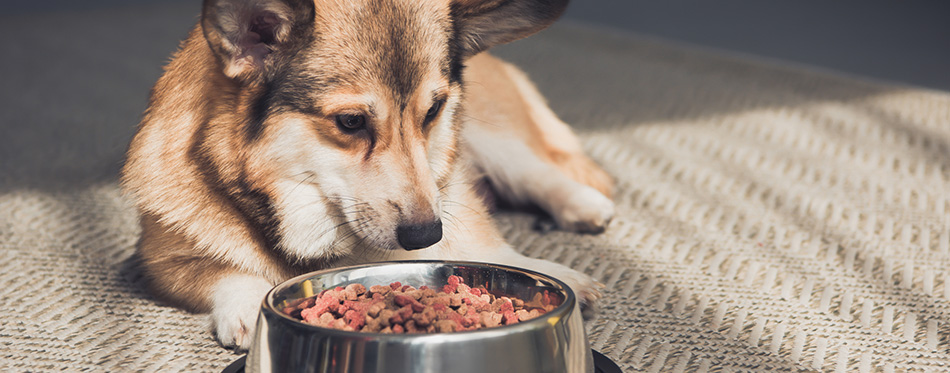
Is My Dog Overweight?
If you really want to know if your dog is overweight or not you really need to weigh your dog and then compare its weight with the breed’s standard. To give you an idea, we’ve listed herein some of the more common breeds of dogs and their ideal body weights.
- Chihuahua – not heavier than 6 pounds both for males and females
- German shepherd – 65 to 90 pounds for males and 50 to 70 pounds for females
- Golden retriever – 65 to 75 pounds for males and 55 to 65 pounds for females
- Pug – 14 to 18 pounds for both males and females
- Rottweiler – 95 to 135 pounds for males and 80 to 100 pounds for females
This is not to say that you really have to rely solely on the weighing scale to check if your dog is overweight or not. Here are some telltale signs that will tell you your dog may already be on its way to a serious weight issue.
You may also like our guides on Dog Food for Chihuahuas, Dog Food for German Shepherds, Dog Food for Pugs, Dog Food for Golden Retrievers, and Dog Food for Rottweilers.
Difficulty ‘Feeling’ the Ribs
Ideally, when you run your fingers over your dog’s chest you should be able to feel its ribs without any difficulty. If you can do this, then your dog is not overweight. However, if you find yourself having to ‘dig’ deeper or push harder with your fingers just to feel your dog’s ribs, then your canine friend may already be overweight.
Absence of Body Form or ‘Definition’
If you look at your dog, you should be able to have a very clear idea of where the chest, tummy, and waist are. This is their body form or their body definition. If you look from above and you see your pet’s belly protruding from the sides you’re looking at a very obvious distention of its abdomen. If you look at your dog from the side and you cannot see the characteristic waist and abdominal tuck then your dog is definitely obese.
The Inability of Your Dog to Groom or Scratch Itself
If your dog cannot groom itself or even scratch itself, provided there are no known medical conditions that may prevent your dog from doing such things, then it is more likely that your dog is already obese. The extra padding of fat on its body prevents the optimum range of motion of the joints that even a simple act of scratching may already be too difficult for your doggie.
Excessive Panting Even in Normal Situations
Try observing your dog how long it would take before it starts to pant heavily when you’re doing your daily walks. Does your hound begin to pant after a mile or is it after a block or two? If it is the latter, then there is a chance that your pet is already overweight. Of course, you’d have to consider the weather, too. If it’s too hot outside then you know that your dog will pant a lot faster than usual.
Difficulty Moving About
If your dog doesn’t have arthritis or any other condition that might affect its mobility it should be able to move about with relative ease. It can hop onto your couch or won’t have problems getting up and out of its bed. If not, then there is a likely chance that your pet is overweight.
Digestive Issues
While not necessarily a definitive sign of weight issues, it is a very common observation that overweight dogs tend to have constipation and gas more frequently than normal-weight hounds. This is especially true if your dog has no known medical conditions.
What Causes Dogs to Gain Weight?
There are many reasons why dogs can gain weight. While some are the direct result of chronic health problems, a great majority of the reasons are highly preventable. Here are some of the more common causes of canine weight gain.
Too Much Food
The food we give to our pets contains calories. These calories come from carbohydrates, proteins, and fats. Ideally, there should be a balance between energy intake and energy output. In simple words, the number of calories that your dog will consume should be commensurate to the number of calories that it needs to perform all of its vital functions as well as other important activities of canine life. If there are substantially more calories than are taken in than the number of calories that are utilized by your dog, then these excess calories will have to be processed in another way.
Excess calories, usually from carbohydrates in the form of glucose, are converted into fatty acids and glycogen. These are stored in the dog’s body so that, in the event that there is a need for energy and the next meal is still several hours away, your dog will have something to utilize for energy.
Unfortunately, what happens is that by the time the next meal is around, this stored energy has not been used up. Yet you are now giving your dog another serving of the same amount of calories in its food. Over time, this leads to excessive storage of fats leading to obesity.
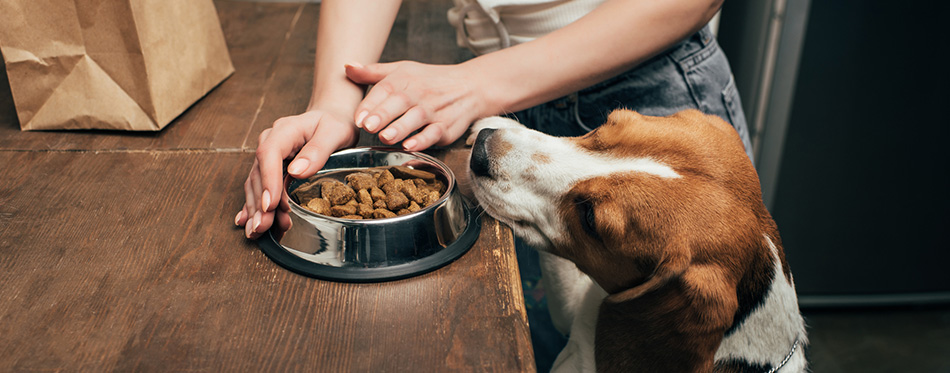
Too Little Exercise
In addition to giving too much food to our dogs, weight gain can also be caused by too little or no exercise at all. Remember what we said about energy intake equals energy output? Well, energy intake is the food while energy output is physical activity. If you cannot do away with giving your dog too much food, then you also have to increase its physical activity so that your dog will use up all that stored energy. Otherwise, you will really risk your dog gaining weight.
Genetic Predisposition
Some breeds of dogs are genetically-predestined to gain weight over time. Experts say that American cocker spaniels, Shetland sheepdogs, Cairn terriers, Labrador retrievers, beagles, rough collies, basset hounds, Norwegian elkhounds, dachshunds, and Cavalier King Charles spaniels are more prone to gaining weight than other dog breeds.
Chronic Conditions
There are also chronic conditions that can cause a dog to gain weight. These can include Cushing’s disease and hypothyroidism. Cushing’s disease is a disorder of the adrenal glands leading to increased production of cortisol. Hypothyroidism, on the other hand, is very common among Golden retrievers and Doberman pinschers and is characterized by lethargy, infection, hair loss, exercise intolerance, and weakness.
The Dangers of Obesity in Dogs
Just as obesity in humans can cause a variety of health problems, the same thing can be said of dogs that have greater-than-normal body weights. Here are some of the more common dangers of canine obesity.
Increased Risk of Diabetes Mellitus
Having too much fat in the body can increase the risk of diabetes in dogs since the continued intake of carbohydrates only increases sugar levels in the blood. Since these carbs are not utilized by the dog’s body for energy, they are converted into fat and glycogen which further aggravates obesity. Over time, the increased fat deposition leads to insulin resistance causing an increase in glucose in the blood which is no longer moved towards the cells. This increases blood sugar levels and is one of the hallmarks of diabetes. Check out our guide on the best dog food for diabetic dogs for more info.
You may also like our review of Glucose Monitors for Dogs.
Problems Associated With Mobility
Having an unusually heavyweight puts strain and stress on the articular surfaces such as the joints, ligaments, and bones. It is like having a Grand Piano standing on a platform supported by toothpicks. The weight of the dog’s body can exert undue pressure on the joints leading to erosion of the ends of the bones and causing osteoarthritis. This leads to problems in mobility associated with inflamed and painful joints.
Cardiovascular Problems
Having excess calories that are not used by the body requires conversion into fat and glycogen. The more calories not burned the more fat that is stored. These can lead to the deposition of fatty plaques or lesions in the inner walls of blood vessels causing stroke, pulmonary hypertension, systemic high blood pressure, kidney failure, and even heart failure secondary to coronary artery disease.
Difficulty Breathing
When fatty pads accumulate on the chest wall, this restricts the movement of the muscles of respiration. Since breathing is largely a passive thing, the dog will have to exert more force to move air from the environment and into the lungs. The work exerted by the muscles of respiration alone will require a considerable amount of oxygen which cannot be supplied adequately because of the channeling of oxygen to more vital organs of the body.
Fatty Liver Disease
Obesity is one of the most important risk factors in the development of fatty liver disease or steatohepatitis. The other risk factors include insulin resistance, high-fat levels, and high blood sugar all of which are present in a dog that is overweight or obese. The problem with fatty liver disease is that the liver loses its ability to metabolize a lot of the foodstuffs and chemicals that a dog consumes. Over time this leads to cirrhosis which can lead to ascites, liver cancer, and even end-stage liver failure.
Reduced Immune Functioning
One of the most intriguing observations about obese dogs is that they are more susceptible to salmonella and canine distemper virus infections suggesting a faulty immune system secondary to obesity. Unfortunately, the exact mechanism behind this observation remains unclear. It is enough to say that obesity can significantly reduce a dog’s ability to fight infections. And this can have significant implications for its overall health.
Heat Intolerance
Fat is an exceptional tissue when it comes to insulating the body in cold environments. Unfortunately, too much fat may not be good when the environmental temperatures are simply scorching hot. Obese dogs are known to be more vulnerable to heat exhaustion, heat stress, and heatstroke. This can lead to the sudden cessation of nervous system functioning in an effort to preserve whatever functionality is left from vital organs
Increased Risk of Cancer
While the exact mechanism is unknown, obese dogs are known to have a greater chance of developing certain types of cancer but more particularly those related to the urinary bladder. There is also an observation that obese puppies are more likely to develop mammary tumors than normal-weight puppies.
Problems in the Skin and Coat
Underneath the skin is a pad of fatty tissue called subcutaneous fat. Within the dermal layer of the skin are cells that are composed of fat globules. When there is excessive fat in the dog, there is a tendency that your dog will have issues with oily skin and an increased number of skin creases. This can significantly increase the risk of skin infections.
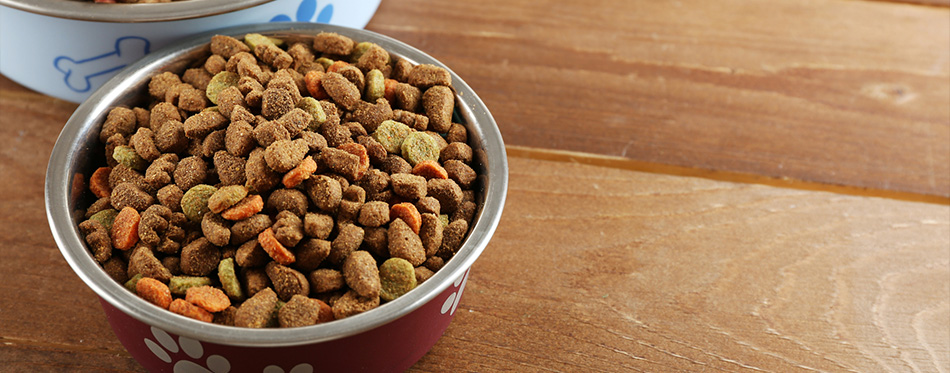
What Makes the Best Dog Food for Weight Loss?
The right dog food for weight loss should have the following nutrient proportions.
Below-average calories
Reducing the number of calories that your dog is taking minimizes the tendency of the body to store the excess calories as fat. The question, therefore, is how many calories your dog is supposed to have so you will have an idea of just how much below-average calories really mean. For instance, if your dog should have 500 calories per meal, then a below-average calorie diet should be less than 500 calories per serving.
Low to below-average fat
Too much fat in the diet can only add up to the fat that is converted and stored by the body from excess glucose. Since the problem with high-calorie dog foods is that there is a chance the excess glucose will be converted into and stored as fat, taking in more fat than necessary will only increase the amount of fat being stored. It is also important to understand that the amount of energy that a single molecule of fat contains is more than the number of calories contained in a similar molecule of carbohydrate and protein combined. That’s how concentrated fat is.
Above-average protein
Protein also contains calories. However, since proteins are unusually large molecules your dog’s body will have to burn more calories just to process proteins and break them down into amino acids. Energy will have to be utilized again to combine these amino acids into building blocks. Technically, increasing protein intake can help save amino acids necessary for building tissues since the dog’s body will inadvertently use some of the proteins for energy.
For more information head over to our guide on High Protein Food for Dogs.
How Many Calories Does Your Dog Need?
Since one of the essential characteristics of good dog food for weight loss is below-average calories, then you should know just how many calories your dog is supposed to consume. Here’s how to check for the calorie requirements of your dog.
- Take your dog’s weight in kilograms. You can use pounds but divide this by 2.2.
- Multiply your dog’s weight in kilograms by 70 and then multiply by the Resting Energy Requirement (RER) constant of 0.75.
- Multiply your dog’s RER by the appropriate multiplier depending on its classification to obtain your dog’s Maintenance Energy Requirement or MER.
The different MER multipliers include the following
- To lose weight – 1.0
- To gain weight – 1.7
- Light activity or work – 2.0
- Moderate activity or work – 3.0
- Heavy activity or work – 6.0
- Neutered – 1.6
- Unneutered – 1.8
- Puppies aged below 4 months – 3.0
- Puppies aged above 4 months – 2.0
Let us say you have a 20-pound dog that you want to lose weight
- 20 pounds divided by 2.2 = 9.09 kilograms
- 09 kilograms x 70 x 0.75 = 477.225 RER
- 225 RER x 1.0 (multiplier for weight loss) = 477.225 calories per day
This means you need to feed your 20-pound dog 477.225 calories per day if you want it to lose weight. A formula is a handy tool. But if you’re having problems, your vet can help.
Obesity in dogs is a serious issue. There are many health implications that can undermine your dog’s overall wellbeing and quality of life. By giving your dog any of these best dog foods for weight loss, you’re giving your furry best friend the chance to lead a more normal, healthier life.
Sources:
- How To Tell If Your Pet Is Obese — And Why It Matters, Animal Humane Society
- Nutrition Matters, American Veterinary Medical Association
- Sarah Lim, DVM, Seasonal Weight Gain in Dogs: How to Avoid Those Pesky Extra Pounds, The MSPCA–Angell



